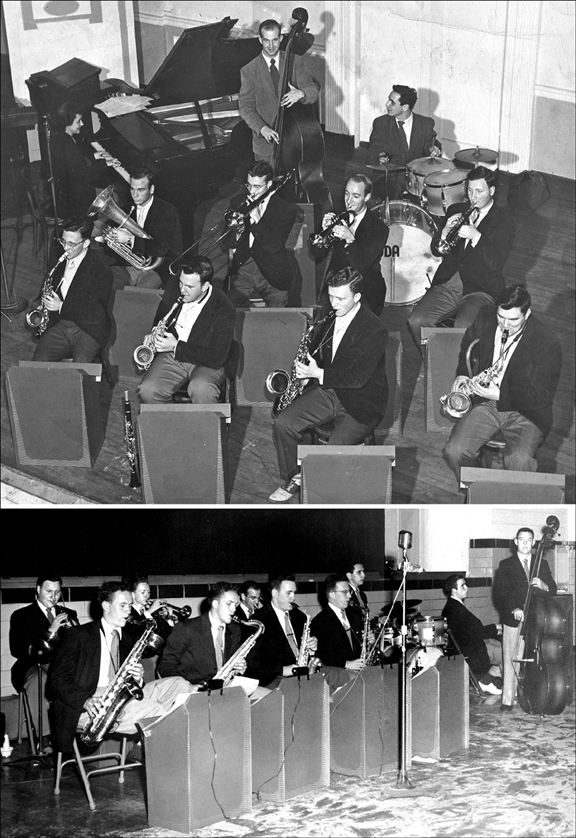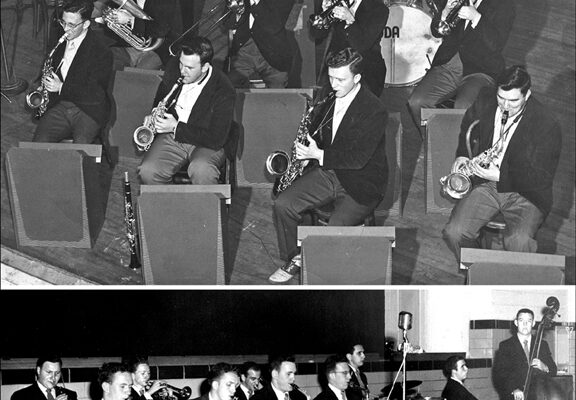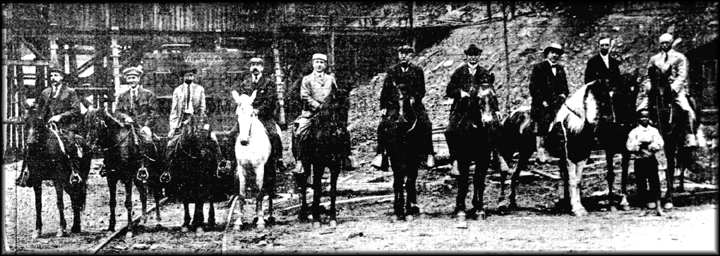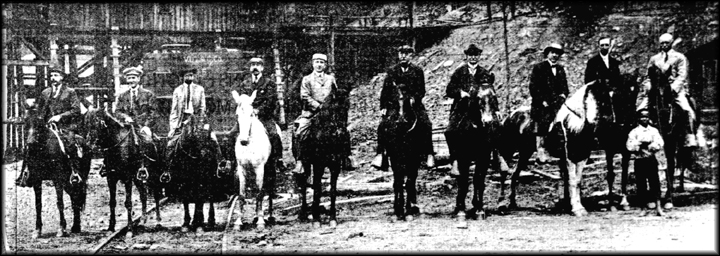Glenn Stroup, an occasional contributor to Johnson City Press’s History/Heritage page, commented on the George Buda feature article. Glenn played with a local band, the Blue Notes, that later became known as The Collegians. He sent me two photographs of the group. “It was a great experience,” he said, “playing in this band because, as valuable as the money was, it was truly enjoyable performing with different musicians and playing a wide variety of popular music.

“The article mentioned the very talented Butch Swaney who played trumpet when we could get him. He usually brought Teresa Alley, a superb pianist, with him. Ivan Tipton, a gifted classical pianist (trained in the classics), often complained about having to play popular music.
“The Collegians specialized in ‘Big Band’ numbers and used sheet music with typical arrangements. Whenever possible, because of the higher fees paid, we attempted to utilize a full set of players that included five saxophones (two alto, two tenor and a baritone) plus at least three trumpets and two trombones. It became my lot to play baritone sax whenever we employed a full complement of instruments.”
Stroup said that regardless what music they played, they tried to emulate the band that originally performed the number. Glenn Miller arrangements were the hardest to follow, at least for the saxophone and clarinet players, because the arrangements often had the latter instruments playing at the highest part of their range.
Glenn commented that with such a variety of talented piano players, they were able to play current popular tunes using only a piano, bass and drums. This allowed the other musicians to take a short break.
According to Stroup: “George mentioned Warren Weddle, who is fondly remembered by a host of Science Hill High School graduates. During our 60th reunion of the Class of 1951, many people talked about their memories of playing in the band or orchestra. Our bandleader’s philosophy was to accept all students and play a wide selection of music throughout the year rather than concentrate on a few members that the band could play in competitions.
“Mr. Weddle also worked with the Red Shield’s Boy's Club, when it was located at 228 W. W. Market, and formed a “dance band” there as well. I was fortunate enough to participate in that group. The club’s director got us on the program for the National Boy's Club convention in Washington DC one year. Bob Byrd was the drummer.
“It was also very nostalgic to see Don Shannon's name mentioned by George. Don lived next to me in the Holston Apartments on W. Main. Mr. Weddle assigned me the task of getting him to band parades on time. For several years, Don was the drum major and it was essential for him to be prompt. He was tremendously talented but had absolutely no sense of time. He was very good on alto sax. Incidentally, Don's mother, Nell, was a niece of J.J. Paige, the carnival owner who wintered in Johnson City.”
The “Mountain Mischief” brochure is from a performance presented by the Junior Service League at Science Hill’s auditorium on April 10-11, 1964. This was three years after the relocated school opened its doors. Information on the front cover of the publication gives specifics of the production crew: Choreography and Direction by Joe Landis; Produced by Jerome N. Cargille, 140 Fifth Avenue, New York, New York; Orchestra by “Butch” Swaney Orchestra; Rehearsal Pianists, Mrs. Edwin L. Pace and Mr. Cecil Gray; Professional Photography, Clifford Maxwell Studio; Cover design and Art Work, Frank Webb; and Makeup, Deeya Cosmetic Studio.
Identification of individuals in the top photo (left to right): Front row: 1. Glenn Stroup, 2, Buddy Beasley, 3. Don Shannon and 4. (unknown). Second row: 5. Earle Guffey, 6. Gordon Vest, 7. Joe Goolsby and 8. Larry Burleson. Third row: 9. Teresa Alley, 10. Don Barnett and 11. George Buda.
Personnel in the bottom photo: Front row: 1. (unknown), 2. (unknown), 3. Buddy Beasley and 4. Glenn Stroup. Second row: 5. Larry Burleson, 6. Bill Green, 7. Earle Guffey, 8. George Buda, 9. Ambers Wilson and 10. (unknown).
Glenn noted that many of the people in the photos went into military service bands. George Buda and Earle Guffey were in Army bands and Larry Burleson left college to join the Navy and played in a Navy band. Buddy Beasley joined the Air Force after college, became a fighter pilot and was killed in a non-combat flight accident.
It is sad to see several unknowns in the photograph. If Press readers can identify any of them or have addition info to share about the once popular band, please share it with us. We appreciate George Buda, Ambers Wilson, Sarah Booher and Joe Henley (who started his own band in 1955 and played music for 40 years) for assisting with this article.




